 Batanes is uncharted territory to many. But this remote province can provide the most romantic of backdrops for any vacation. As the 32-seater SEAIR Dornier plane we were on broke through the clouds as we made our descent, the islands of Batanes beckoned. We were making our way to a land literally detached from the Philippines; but with distinct Filipino charm and hospitality.
Batanes is uncharted territory to many. But this remote province can provide the most romantic of backdrops for any vacation. As the 32-seater SEAIR Dornier plane we were on broke through the clouds as we made our descent, the islands of Batanes beckoned. We were making our way to a land literally detached from the Philippines; but with distinct Filipino charm and hospitality. It was unusually sunny after several days of rain. And Mt. Iraya was clearly visible when we touched down at the airport. We booked our hotel in advance to make sure we got picked-up at the airport.
It was unusually sunny after several days of rain. And Mt. Iraya was clearly visible when we touched down at the airport. We booked our hotel in advance to make sure we got picked-up at the airport.As soon as we settled down, we arranged tours of Basco and the rest of Batan Island at the hotel counter. You can rent a van for yourself but we opted to share expenses with other guests of the hotel who wanted the same tour. It can save you a lot since there’s lots of room in the van anyway.

 The itinerary for the morning was a tour of the provincial capital Basco which took us to places like Rolling Hills, the Naidi Hill Lighthouse, the town proper and Valugan Beach.
The itinerary for the morning was a tour of the provincial capital Basco which took us to places like Rolling Hills, the Naidi Hill Lighthouse, the town proper and Valugan Beach.Rolling Hills was picturesque and the winds were strong and refreshing. You’d see cows grazing along the steep slopes, which is an iconic image of Batanes.
 Many people actually think that the lighthouse in Naidi Hill and several others date back to the colonial period. But they are actually of recent construction, part of a project of former Batanes congressman Butch Abad. From the top of the lighthouse, we were afforded a bird’s-eye view of Basco and the fishing activities down at the coast.
Many people actually think that the lighthouse in Naidi Hill and several others date back to the colonial period. But they are actually of recent construction, part of a project of former Batanes congressman Butch Abad. From the top of the lighthouse, we were afforded a bird’s-eye view of Basco and the fishing activities down at the coast.
 In Basco town, we got to visit the cathedral and the colonial period provincial capitol building. Batanes churches actually have a distinct look which reminds me of colonial mission churches in the Americas.
In Basco town, we got to visit the cathedral and the colonial period provincial capitol building. Batanes churches actually have a distinct look which reminds me of colonial mission churches in the Americas.We made one last stop at Valugan Beach, which is actually composed of large boulders and not sand, but with a breathtaking view nonetheless. Lunch was at the hotel before we proceeding to visit more of Batan Island.
Part 2: Marlboro Country, Mahatao Church and more from Batan Island
Part 3: Batanes stone houses in Savidug and Chavayan, Nakabuang Beach and more from Sabtang Island
Part 4: Batanes hotels and restaurants plus exploring Batanes by bike





